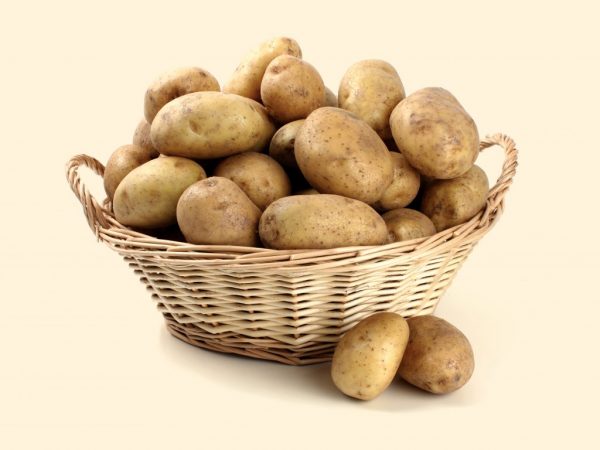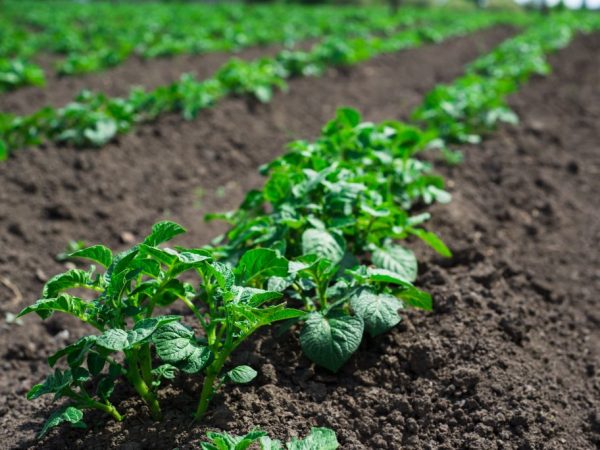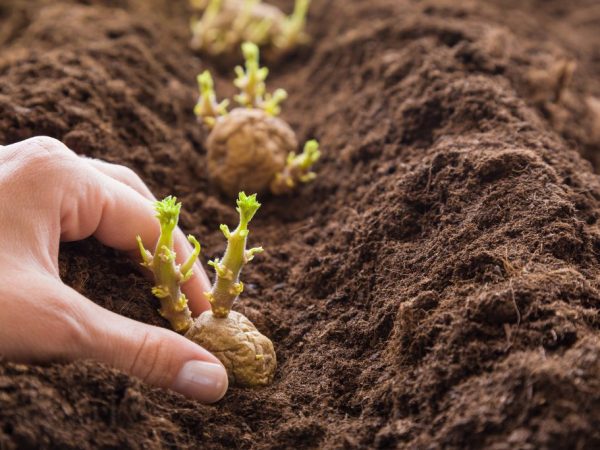Description of Assol potatoes
Assol potatoes are an early variety. Bred in Russia. Differs in stable indicators of productivity in any climate.

Description of Assol potatoes
Description of potatoes
Assol potatoes are the most popular early variety. The ripening period is 50-70 days, depending on growing conditions and climatic zone. Gives a stable increase in yield. Early ripening periods make the potatoes of this variety resistant to such a dangerous disease as late blight. Possesses good keeping rates.
Plant characteristic
- plants are erect, semi-spreading type;
- foliage and stem are bright green;
- leaves are medium in size, with slightly uneven outer edges;
- flowers are white.
Characteristics of the fetus
The tubers are elongated, oval in shape. The rind is yellowish with a smooth texture. The eyes are small, evenly distributed throughout the tuber.
The flesh on the cut is yellow, does not lose color during heat treatment. Used to prepare various culinary delights.
Advantages and disadvantages
The undoubted advantage of the early Assol potatoes is a low susceptibility to late blight and the ability to grow a crop 2 times per season. High taste characteristics make it suitable for the preparation of all kinds of dishes and use in industrial production. The variety perfectly adapts to the climate conditions of any region, is not picky about the composition of the soil.
Assol potatoes are not whimsical to care, they are perfectly preserved throughout the winter without loss of taste. Like all other varieties of nightshade crops, it is attacked by the Colorado potato beetle. This is perhaps the only drawback.
Agrotechnics

Plants need to be looked after
You can increase yields by following the rules of agricultural technology and ensuring optimal care. All varieties of potatoes are thermophilic plants, therefore, the site must be selected open. Planting potatoes should be carried out from north to south in order to provide the bushes with the necessary amount of vitamin D, which is produced by the sun's rays.
Assol potatoes respond well to loosening and fertilization. It is important to follow the rules of crop rotation:
- select healthy tubers for planting;
- do not plant potatoes in the same place for several years in a row.
Soil preparation
The qualitative composition of the soil plays a significant role in the cultivation of root crops. The highest yields are observed on sandy loam soils. They begin to prepare the soil immediately after harvesting the entire crop from the garden. If it is not possible to change the site for planting, green manure plants are planted on it, which include winter crops, flax, and legumes.
In the fall, the site needs to be dug up, organic fertilizers or superphosphates must be applied. Cultivation is carried out to a depth of 30 cm or more. If there are too many weeds in the area, you can use herbicide products.In addition to weeds, they help to destroy the larvae of the Colorado potato beetle, which are buried in the ground in the fall to a depth of 50 cm. In the spring, the soil is fertilized and cultivated again. In the spring, it is not recommended to use fresh mullein or bird droppings.
Seed preparation
Seeds are also started in the fall. During harvesting, sorting is carried out, whole even root crops are taken for seeds, some are left for food, the rest is in reserve. To ensure good keeping quality and protect from rodents, the potatoes should be planted. If weather conditions permit, the roots are laid out in an open area for 2 days. When it is not possible to leave vegetables outside, it is stored in a well-lit room for 7 days.
In the spring, seeds are germinated using any convenient method. Potatoes can be propagated with tubers, seedlings, or collected seeds during the formation of berries on the bushes. Collecting seeds from bushes is quite difficult, moreover, this activity requires certain breeding knowledge. Reproduction by seedlings can increase the yield by 30-40%. To do this, after sprouting the potatoes, the sprouts are removed and planted in boxes.
Landing

Planting depth depends on the soil
The description of the variety makes it possible to understand that the method of planting potatoes is determined depending on the type of soil. The shovel landing is considered universal and the most commonly used. The depth of planting seeds on heavy soils is no more than 5 cm, on light soils - 12 cm. Between the holes 40 cm are left, between the rows 60-70 cm.
Assol potatoes should be planted when the soil warms up by 10 ℃. At the planting stage, nitrogen and potassium fertilizers need to be applied. It is these minerals that plants need for optimal development. To prevent the appearance of pests, onion peels are placed in each hole. Instead of potassium solutions, wood ash can be used.
Care
Good care ensures a good harvest. Potato care is determined by a whole range of activities. Watering Assol potatoes as needed. In regions with an arid climate, watering is carried out every 10 days, water is poured gently under the bushes.
The best solution for moisture control is the drip irrigation system. Plants respond well to cultivation and regular application of vitamin complexes. To protect plantings from possible frosts, systematic hilling is carried out in parallel with loosening.
Hilling and loosening the soil
These activities should not be neglected. They help to increase yields by 20%. All innovative potato growing schemes are based on providing the root system with an optimal amount of oxygen. Earthen embankments near the bushes begin to form when the shoots reach a height of 12 cm, the second time the procedure is carried out after 21 days. In addition to frost protection, a beautiful bush is formed with the help of hilling, which does not collapse under the influence of all sorts of mechanical factors.
It is especially important to carry out hilling in the northern regions and in areas blown by the winds. Loosening of the soil is carried out to a depth of 10 cm, simultaneously removing weeds, which take nutrients and moisture from the potatoes. Cultivation is carried out as needed, after watering and rains, in order to avoid the formation of a hard crust on the soil surface.
Top dressing
The culture is fed several times until the end of flowering. They use all kinds of mineral fertilizers, superphosphates and organic matter. Chicken manure solution is often used as fertilizer. Add 0.5 kg per 10 l of water and infuse for 7 days. Then it is diluted with water and the bushes are watered.
Supporters of environmentally friendly fertilizers use herbal infusions of nettle, pine needles, and garlic. It is recommended to feed the plants before the first hilling, and then 2 more times with an interval of 14 days. The main thing is to finish all procedures before the end of flowering.
Diseases and pests
An early potato variety Assol is characterized by high resistance to all kinds of diseases. But, do not neglect the disinfection of tubers before planting, especially if you plan to plant potatoes 2 times per season. Preventive spraying with systemic fungicides is also carried out before the end of flowering.
A malicious pest of potato plantings is the Colorado potato beetle. Adult beetles and larvae can be in the ground all winter. If the females managed to mate in the fall, then in the spring they will begin to lay eggs on young shoots. For the prevention and destruction of the Colorado potato beetle, the following drugs are most often used: Regent, Colorado, Hurricane, Prestige.
If there are not many pests, it is better to collect them by hand. In addition, many farmers use a solution from the beetles themselves to spray the bushes. Pests accumulate solanine poison in themselves. The insects are collected in a jar and soaked in water for a week, then the resulting liquid is diluted with water 1: 1.
Harvesting
Harvesting times will depend on growing conditions and climate. They begin to dig Assol's potatoes when the tops begin to turn yellow. Pre-dig out 1 bush and check the rigidity of the peel. 10 days before harvesting the potatoes, all the tops are cut off. In a week, the peel becomes tighter, and the roots themselves acquire that unique taste for which farmers value it so much. In addition, cutting the tops avoids infection with many diseases, because most of the pathogenic microorganisms are located on the greenery.
The tops should not be left on the site; it is better to feed it to pets. Potatoes are sorted right in the garden. After digging, it is left in the sun for several hours. It is important to remember that after staying in direct sunlight for more than 2 hours, solanine begins to be produced in root crops. Then the tubers are moved under a canopy for 2 weeks, gradually reducing the air temperature to 2-4 ℃.
Do not forget that before laying in the vegetable store, you need to disinfect the floor, walls, shelves and stairs. The cellar should be equipped with basic ventilation, as well as a thermometer and moisture meter. A decrease or increase in one of the indicators leads to crop damage, rapid germination of seed potatoes.


